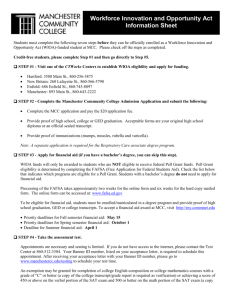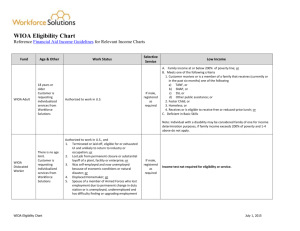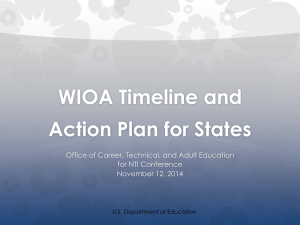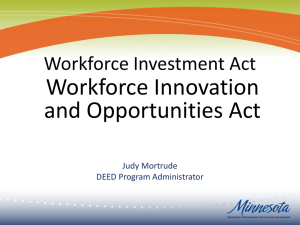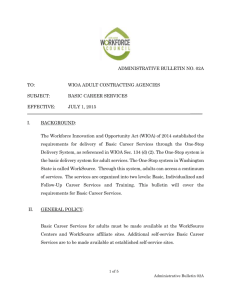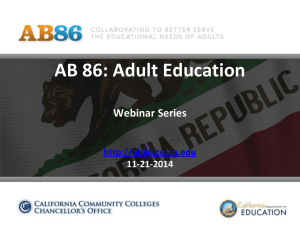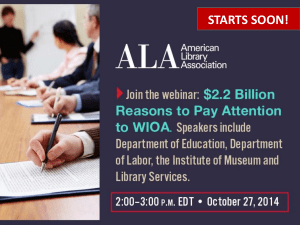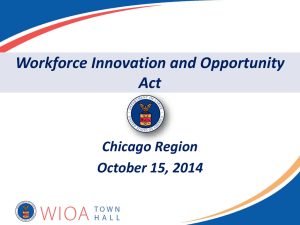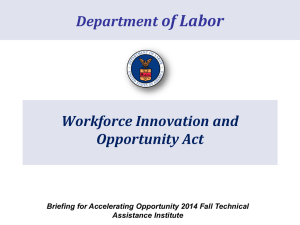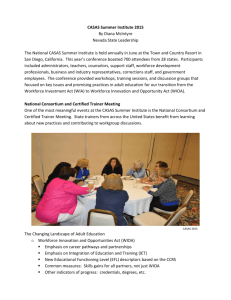Angela Hanks Presentation
advertisement
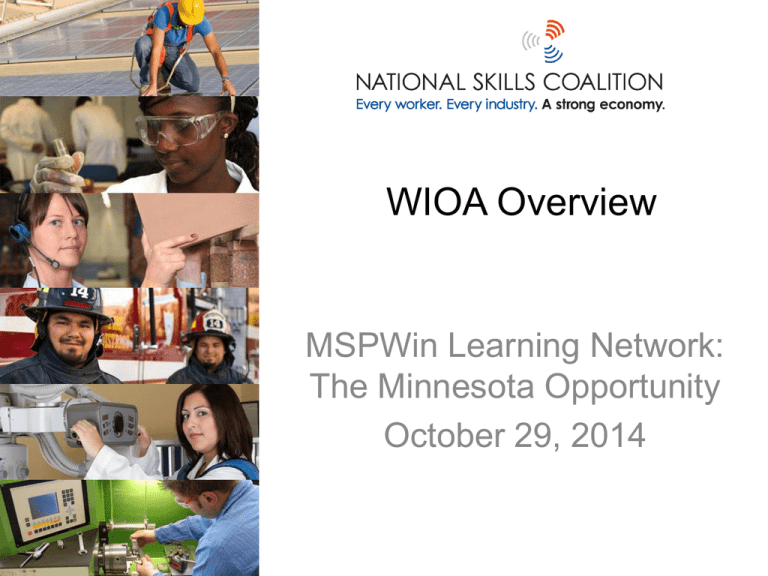
WIOA Overview MSPWin Learning Network: The Minnesota Opportunity October 29, 2014 Our Vision We seek an America that grows its economy by investing in its people, so that every worker and every industry has the skills to compete and prosper. www.nationalskillscoalition.org Our Mission • We organize broad-based coalitions seeking to raise the skills of America’s workers across a range of industries. • We advocate for public policies that invest in what works, as informed by our members’ real-world expertise. • And we communicate these goals to an American public seeking a vision for a strong U.S. economy that allows everyone to be part of its success. www.nationalskillscoalition.org New Focus on Skilled Workforce Issues • Passage of Workforce Innovation and Opportunity Act (WIOA) • SNAP E&T in the Farm Bill • Administration’s review of federal job training programs • Higher education and student loan debt • Career and technical education www.nationalskillscoalition.org Workforce Innovation and Opportunity Act (WIOA) www.nationalskillscoalition.org WIOA: How Did We Get Here • WIOA is a compromise between the SKILLS Act and the HELP committee passed bill • Very limited amendments and debate (“preconferenced”) • Passed with overwhelming, bipartisan support in both the House (415-6) and Senate (95-3) www.nationalskillscoalition.org WIOA is a “May” not a “Shall” • In order to pass, could not make huge changes to existing law • Will not, by itself, drive systems change • Creates lots of opportunities for change, but will need strong commitment from the field to capitalize on those opportunities www.nationalskillscoalition.org WIOA: Four Themes • Sector Partnerships • Career Pathways • Cross-Program Data and Measurement • Job-Driven Investments www.nationalskillscoalition.org WIOA: What’s Different? • Maintains basic structure of current law (i.e., an occupational training title; an adult basic education, literacy and English language acquisition title; Wagner-Peyser; and vocrehab) • Maintains formula funding, does not block grant or otherwise consolidate programs • Eliminates 15 programs, including WIA incentive grants, the WIF, and pilots and demos www.nationalskillscoalition.org WIOA: What’s Different? • • Workforce Investment Boards (WIBs). Maintains structure of state and local WIBs continuing to require a business majority and chair. Number of required members is reduced State and local plans. Requires a single, unified State plan covering all core programs. Plan must describe the State’s overall strategy for workforce development and how the strategy will meet identified skill needs for workers, job seekers and employers. Local plans must be aligned to the strategy described in the State plan, and must describe how services provided at the local level will be aligned to regional labor market needs www.nationalskillscoalition.org WIOA: What’s Different? • • Performance measures. Creates a single set of common measures across core programs, including: unsubsidized employment; median earnings; receipt of a secondary diploma or recognized postsecondary credential; measurable skills gains toward a credential or employment; and employer engagement Funding levels. Includes specific funding levels. Funding levels in FY 2015 are consistent with current funding levels. Increased each year, and reach 2010 levels by FY 2017. These are just authorization levels, actual funding levels will continue to be determined through the appropriations www.nationalskillscoalition.org WIOA: What’s Different? • • Employment and Training Activities. Eliminates “sequence of services,” and combines core and intensive services into a new “career services” category. Signals interest in seeing best practices adopted or expanded, including: career pathways; industry or sector partnership (local WIBs are required to “convene, use, or implement” sector partnerships); and an increased focus on the attainment of industry-recognized certificates and credentials linked to in-demand occupations State-wide set aside. Restored to 15 percent www.nationalskillscoalition.org WIOA: What’s Different? • • One stop delivery system. Requires co-location of employment services and one-stop centers. Establishes infrastructure funding mechanism. Requires state board to establish criteria and process to measure effectiveness and continuous improvement of onestop system. Eligible training providers. Requires consideration of whether training relates to in-demand occupations. Promotes use of providers offering industry-recognized certifications or programs leading to postsecondary credentials. www.nationalskillscoalition.org WIOA: What’s Different? (Youth) • 75 percent of funding must be spent on outof-school youth • 20 percent funding must be spent on workbased learning models (OJT, paid internships, apprenticeships, etc.) • Expands age range to 24 (from 21) • Simplifies eligibility (free or reduced lunch, or living in highpoverty area) www.nationalskillscoalition.org WIOA: What’s Different? (ABE/ESL) • Emphasizes career pathways, integrated education and training, and integrated ESL/civics education • Maintains definition of allowable activity as sub post-secondary, but clarifies that nothing in title should be interpreted as restricting integrated models www.nationalskillscoalition.org Implementation Starts Now • Agencies developing regulations now • DOL, DOEd (and HHS to some extent) working jointly as much as possible • 1-2 year transition period • Advocacy work on implementation has already begun (town halls, webinars) www.nationalskillscoalition.org Success: Be Careful What You Wish For • Most policymakers agree that we need to do more to increase the skills of our workforce • Will be an expectation of improvement under WIOA (and other federal investments); cannot continue to deliver same result overall • Debate about effectiveness of workforce development system not going away www.nationalskillscoalition.org WIOA: Key Dates • Jan 18, 2015: DOL, DOEd, and HHS must publish Notice of Proposed Rule Making • January 22, 2016: DOL, DOEd, and HHS must publish final regs • March 3, 2016: Unified state plans due • June 30, 2016: Employer engagement measure due • NOTE: If states are early implementers, state plans will be due by March 2015 for July 1 start date www.nationalskillscoalition.org Additional Resources • NSC side-by-side • NSC WIOA resource page • DOL WIOA resource page (Title I) • OCTAE WIOA resource page (Title II) • OSERS WIOA resource page (Title IV) www.nationalskillscoalition.org Questions? www.nationalskillscoalition.org Stay Connected • Visit us our website. • Sign up for our member email list. • Follow us on: www.nationalskillscoalition.org Contact Angela Hanks, J.D. Senior Federal Policy Analyst angelah@nationalskillscoalition.org (202) 223-8991, ext. 103 On Twitter @AngelaNSC www.nationalskillscoalition.org
